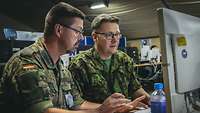
Air Defender 23
Multinational air operation exercise in Europe


Interoperability means the ability of armed forces to cooperate on a multinational basis. It is a key factor for modern armed forces that want to contribute to international stabilisation and crisis management. The German Air Force attaches great value to this – and has done so since the foundation of the Bundeswehr in 1956.

International formations over Northern Germany: Within the scope of Air Defender 23, cooperation with international partners is practiced.
Bundeswehr/Christian TimmigIn the past years, the necessity of interoperability has increased as the threats to our security changed. It is no longer about conventional wars alone, but also about terrorism, organised crime, and violent regional conflicts. To meet these challenges, armed forces and even more the air forces must be able to cooperate with partners in an effective manner and act in multinational operations. NATONorth Atlantic Treaty Organization and its member states, in particular, recognised that the strengthening of interoperability is crucial to respond to these new threats.
Often, interoperability is superficially equated with the intent to cooperate. But strictly speaking, it is only the prerequisite for cooperation. Interoperability must be considered and implemented on three levels: the mental one, the structural one, and the materiel one. Mental interoperability pertains to a common language, the terminology, the doctrine, and the working procedures. It is crucial that all armed forces involved have a common understanding and a uniform approach. Structural interoperability relates to the adaptation of the command structure, the organisation of headquarters and units as well as the availability of communication and information systems. Materiel interoperability includes the compatibility of equipment and logistic cooperation.
The importance of interoperability also becomes apparent on various levels: On the level of security policy, it is about enhanced international cooperation in order to approach common challenges and to maintain peace. On the military-strategic level, interoperability enables armed forces to cooperate in an effective manner and combine their assets. On the operational and tactical levels, specific requirements are defined in order to ensure proper cooperation of units and elements.
Interoperability is not a new idea but has evolved over time. As early as in World War II, different nations fought together. The best example of this is the Allied landing in Normandy on 6 June 1944, in which British and American forces opened a second front in Western Europe. Since its foundation, NATONorth Atlantic Treaty Organization, in particular, has been dealing intensely with this topic. Cooperation in the development of common military concepts and weapon systems has increased considerably over the past decades. A special focus was on the interconnection of command and control, communication and information systems. With the end of the Cold War, however, also mental interoperability became more important.
NATONorth Atlantic Treaty Organization developed its own definition of interoperability, which is concentrated on the practical cooperation of systems, units and forces. With regard to NATONorth Atlantic Treaty Organization’s standardisation process, different levels of cooperation are distinguished, ranging from compatibility to interoperability, to interchangeability and commonality.
Several measures were taken to improve interoperability, one of which is the conduct of combined exercises and training programmes, in which soldiers from different countries are able to work together and adapt their capabilities and procedures. These exercises enable the participants to gain practical experience and train their cooperation in realistic scenarios.
Moreover, standards and guidelines were developed to promote technical interoperability. Communication standards, data formats, and interfaces were harmonised in order to ensure seamless integration of systems and technologies – as a consequence, the different communication systems of the armed forces are compatible with one another.
Another aspect of interoperability is to train the personnel accordingly. The soldiers must have the knowledge and capabilities required to work with partners and act in a multinational environment. This also includes understanding different cultures, obtaining language skills, being familiar with the same tactical procedures, and using similar equipment and technologies.

A German and an Estonian soldier are exchanging ideas during Air Defender 23: It is a standing task of the air forces to further develop interoperability.
Bundeswehr/Marvin HofmannInteroperability remains to be a constant challenge since technologies and threats are constantly evolving. It is, therefore, important that the armed forces verify and adapt their interoperability efforts on a continuous basis in order to meet the latest requirements.
by Thomas Skiba
Multinational air operation exercise in Europe